What is a Series-Parallel Circuit?
Not all circuits are simple series or parallel arrangements. Many are combinations of parallel resistors connected in series with other resistors or combined with other parallel groups. These can be described as a series-parallel circuit.
The simplest approach to analyzing a series-parallel circuit is to resolve each purely series group into its single equivalent resistance and to resolve each parallel group of resistors into its equivalent resistance. The process is repeated as many times as necessary.
As in all types of circuits, open-circuit and short-circuit conditions affect the currents and voltage drops throughout the circuit.
Series-Parallel Resistor Circuits
Simple Series-Parallel Circuit
Series-Parallel resistor circuits consist of combinations of series-connected and parallel-connected resistors. Figure 1 shows a circuit diagram of a very simple three-resistor series-parallel circuit. Resistors R2 and R3 are seen to be connected in parallel, and resistor R1 is in series with the parallel combinations of R2 and R3. The circuit currents vary from branch to branch, and the component voltage drops depend on the branch currents and on the component resistances. The supply current depends on the supply voltage and on the circuit resistance offered to the voltage source. Kirchhoff’s voltage and current laws are applied for analyzing series-parallel circuits.

Figure 1: Circuit Diagram of Series-Parallel Circuit
Series-Parallel Equivalent Circuits
In the circuit shown in figure 2 (a), resistors R2 and R2 are in parallel, and together they are in series with R1. The level of current taken from the supply is easily calculated if R2 and R3 are first replaced with their equivalent resistance (R2||R3) as illustrated in figure 2(b). The circuit now becomes a simple two-resistor series circuit.
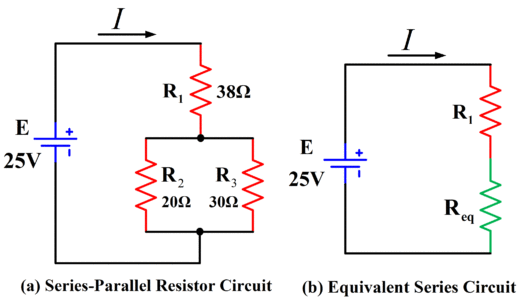
Figure 2: Series-Parallel Circuit and Equivalent Circuit
- You May Also Read: Series Circuit Definition & Series Circuit Examples
Series-Parallel Circuit Example 1
Calculate the current drawn from the supply in the circuit shown in figure 2 (a).
Solution
Draw the equivalent circuit as in figure 2 (b) with
${{R}_{eq}}={{R}_{2}}||{{R}_{3}}$
To compute equivalent resistance:
\[{{R}_{eq}}=\frac{{{R}_{2}}*{{R}_{3}}}{{{R}_{2}}+{{R}_{3}}}=\frac{20*30}{20+30}=12\Omega \]
\[I=\frac{E}{{{R}_{1}}+{{R}_{eq}}}=\frac{25}{38+12}=0.5A\]
In figure 3 (a), another series-parallel resistor combination is shown. In this case, the circuit is reduced to a simple parallel circuit when R2 and R3 are replaced by their equivalent resistance. [See Figure 3(b)]

Figure 3: Series-Parallel Circuit and its Equivalent Circuit
- You May Also Read: Parallel Circuit Definition & Parallel Circuit Examples
Series-Parallel Circuit Example 2
Determine the level of the supply current for the circuit shown in figure 3 (a).
Solution
Draw the equivalent circuit as in figure 3(b).
${{R}_{eq}}={{R}_{2}}+{{R}_{3}}=35+40=75\Omega $
R1 and Req are in parallel:
$R={{R}_{1}}||{{R}_{eq}}$
To compute equivalent resistance:
\[R=\frac{{{R}_{1}}*{{R}_{eq}}}{{{R}_{1}}+{{R}_{eq}}}=\frac{50*75}{50+75}=30\Omega \]
\[I=\frac{E}{R}=\frac{75}{30}=2.5A\]
Current in Series-Parallel Circuit
The circuit of figure 2 (a) is reproduced in figure 4 with the branch currents and voltages identified. It is seen that the supply current flows through resistor R1 and that it splits up into I2 and I3 in order to flow through R2 and R3. Returning to the supply negative terminal, the current is once again I. it is seen that
$I={{I}_{2}}+{{I}_{3}}$

Figure 4: Current and Voltage in Series-Parallel Circuit
Similarly, the supply current splits up between the resistors in figure 5, which is a reproduction of a circuit shown in figure 3 (a). Here I1 flows through R1, and I2 flows through R2 and R3, and the supply current is
$I={{I}_{1}}+{{I}_{2}}$
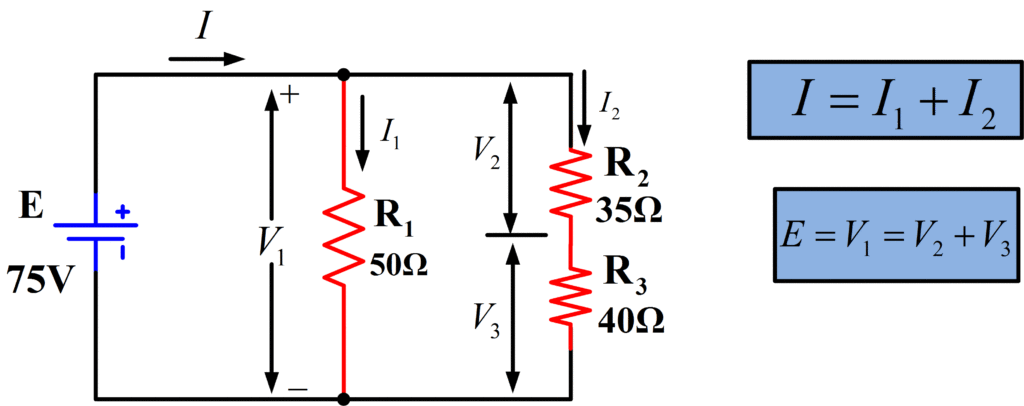
Figure 5: Currents and Voltages in Series-Parallel Circuit
In each of these cases, the current through the individual resistors can be calculated easily using current-divider rule.
Voltage Drops in Series-Parallel Circuit
As always, the voltage drop across any resistor is the product of the resistance value and the current through the resistor. In figure 4,
${{V}_{1}}=I{{R}_{1}}$
And
${{V}_{2}}={{I}_{2}}{{R}_{2}}={{V}_{3}}={{I}_{3}}{{R}_{3}}$
Also,
$E={{V}_{1}}+{{V}_{2}}$
Similarly, in figure 5,
${{V}_{1}}={{I}_{1}}{{R}_{1}}$
${{V}_{2}}={{I}_{2}}{{R}_{2}}$
${{V}_{3}}={{I}_{2}}{{R}_{3}}$
$E={{V}_{1}}={{V}_{2}}+{{V}_{3}}$
Series-Parallel Circuit Example 3
Using the voltage divider theorem, analyze the circuit in figure (a) below to determine the resistor voltage drops and the branch currents.
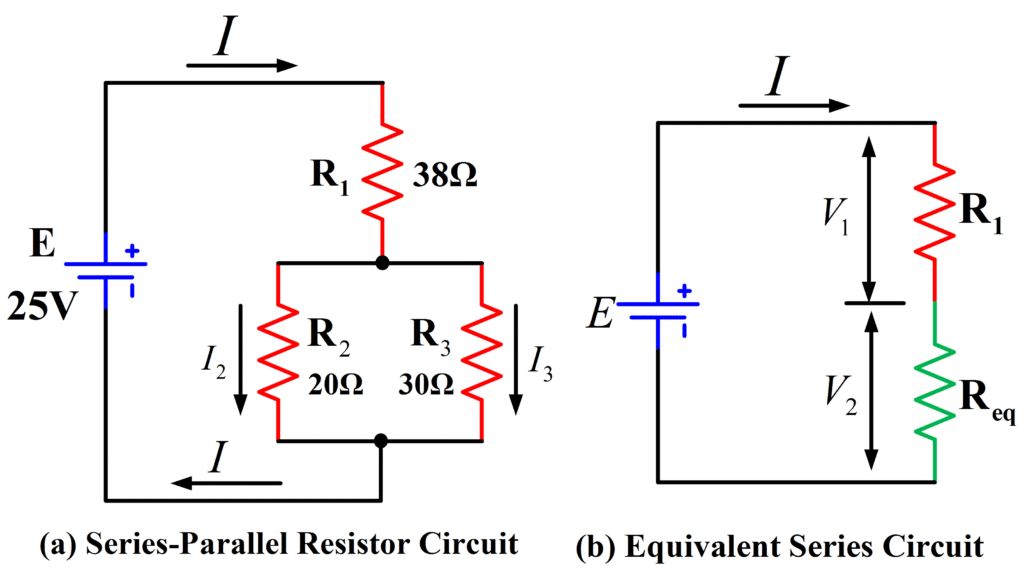
Figure. Series-Parallel Circuit Example
Solution
\[{{R}_{eq}}={{R}_{2}}||{{R}_{3}}\]
\[{{R}_{eq}}=\frac{{{R}_{2}}*{{R}_{3}}}{{{R}_{2}}+{{R}_{3}}}=\frac{20*30}{20+30}=12\Omega \]
For voltage divider R1 and Req, as shown in figure (b) above:
\[{{V}_{2}}=E*\frac{{{R}_{eq}}}{{{R}_{1}}+{{R}_{eq}}}=25*\frac{12}{38+12}=6V\]
\[{{V}_{1}}=E*\frac{{{R}_{1}}}{{{R}_{1}}+{{R}_{eq}}}=25*\frac{38}{38+12}=19V\]
For branch currents:
\[I=\frac{{{V}_{1}}}{{{R}_{1}}}=\frac{19}{38}=0.5A\]
\[{{I}_{2}}=\frac{{{V}_{2}}}{{{R}_{2}}}=\frac{6}{20}=0.3A\]
\[{{I}_{3}}=\frac{{{V}_{3}}}{{{R}_{3}}}=\frac{6}{30}=0.2A\]
Series-Parallel Circuit Formula
The formula for calculating the total resistance (RT) in a series-parallel circuit depends on the arrangement of resistors. Here are the formulas for common series-parallel circuit configurations:
- Resistors in Series: RT = R1 + R2 + R3 + … + Rn
- Resistors in Parallel: 1/RT = 1/R1 + 1/R2 + 1/R3 + … + 1/Rn
- Series-Parallel Combination: To calculate the total resistance in a complex series-parallel circuit, first simplify the circuit by identifying series and parallel sections. Then use the formulas for resistors in series and parallel to find the equivalent resistance of each section. Finally, combine the equivalent resistances to determine the total resistance of the circuit.
Open-Circuit and Short-circuit in a Series-Parallel Circuit
The effect of an open-circuit or short-circuit condition on a series-parallel circuit depends on just where in the circuit the fault occurs. Consider figure 6, where an open-circuit is shown at the end of R1. This has the same effect as an open-circuit in the supply line so that all current levels are zero. Also, because the currents are zero, there are no voltage drops across resistors, and consequently all of the supply voltage E appears across the open-circuit.
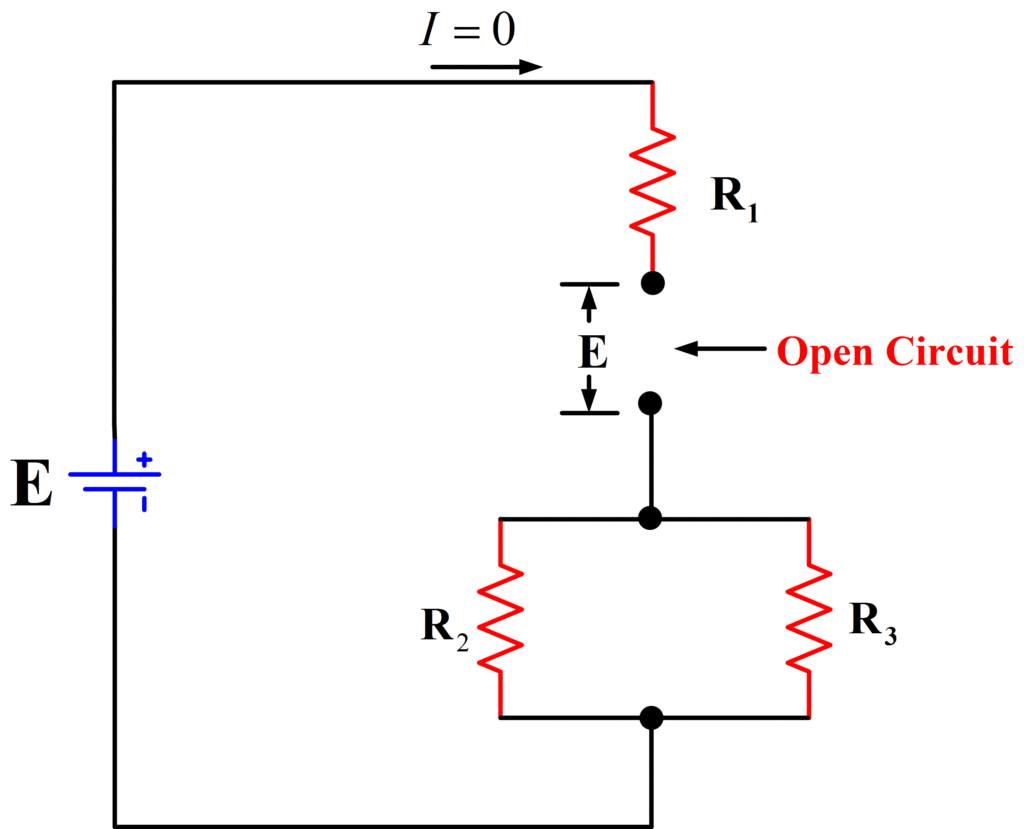
Figure 6: Open-Circuit at Resistor R1
An open-circuit in one branch of a series-parallel circuit usually alters the current levels in several branches of the circuit.
In the case of an open-circuit at one end of the parallel resistors, as shown in figure 7, I2 goes to zero. The current through R1 and R2 is now equal to the supply current and is calculated as
\[I=\frac{E}{{{R}_{1}}+{{R}_{2}}}\]
Also, because there is no current through R3, there is no voltage drop across it, and the voltage at the open circuit is equal to V2.

Figure 7: Open-Circuit at Resistor R3
For the short circuit condition shown in figure 8, the resistance between the terminals of R1 is effectively zero. Therefore, the supply voltage appears across R2 and R3 in parallel. This gives a supply current of
\[I=\frac{E}{{{R}_{2}}||{{R}_{3}}}\]
And the branch currents are
\[{{I}_{2}}=\frac{E}{{{R}_{2}}}\]
And
\[{{I}_{3}}=\frac{E}{{{R}_{3}}}\]
It is seen that the levels of current through R2 and R3 have been increased from the normal (before the short-circuit) condition. This could cause excessive power dissipation in the components if they have previously been operating near their maximum rating.
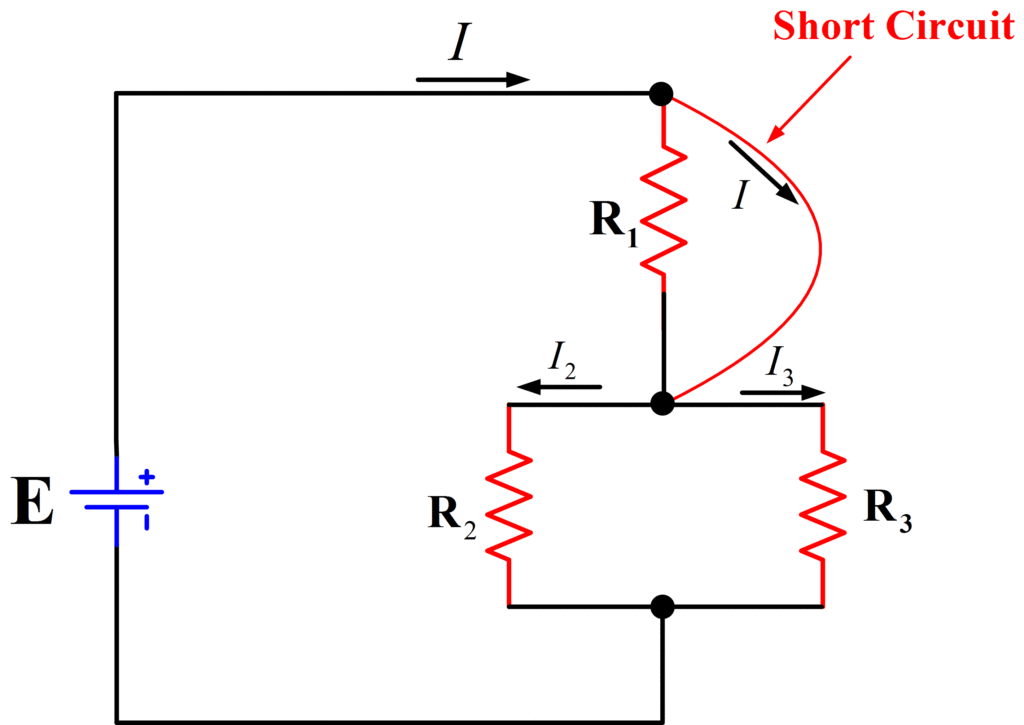
Fig.8: Short-Circuit Across Resistor R1
A short-circuit in one branch of a series-parallel circuit usually alters the current levels in several branches of the circuit.
The short-circuit condition illustrated in figure 9 effectively reduces I2 and I3 to zero and increases the supply current to
\[I=\frac{E}{{{R}_{1}}}\]
Obviously, the current through R1 is now greater than normal, and again power dissipation might present a problem.
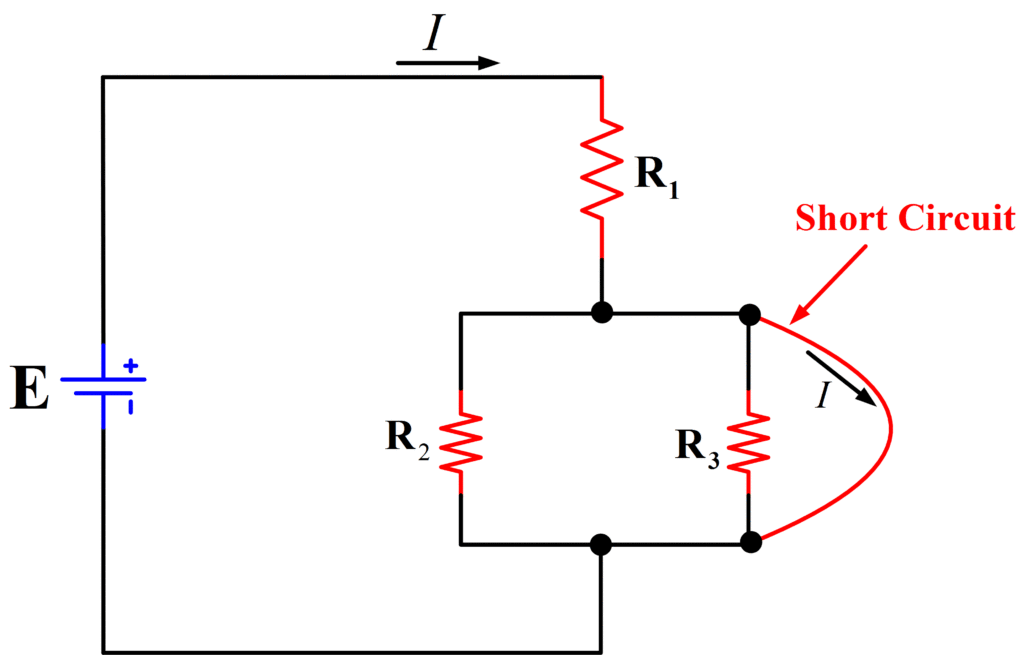
Fig.9: Short-Circuit Across Resistor R3
Analyzing a Series-Parallel Circuit
Analysis procedure for series-parallel resistor circuits is as follow:
- Draw a circuit diagram identifying all components by number and showing all currents and resistor voltage drops.
- Convert all series branches of two or more resistors into a single equivalent resistance.
- Convert all parallel combinations of two or more resistors into a single equivalent resistance.
- Repeat procedures 2 and 3 until the desired level of simplification is achieved.
The final circuit should be straightforward series or parallel circuit, which can be analyzed in the normal way. Once the current through each equivalent resistance, or the voltage across it, is known, the original circuit can be used to determine individual resistor currents and voltages.
Key Takeaways on Series-Parallel Circuit
- Series-parallel circuits combine both series and parallel connections of electrical components.
- They offer flexibility in designing complex electrical systems, allowing for different voltage levels, current paths, and component configurations.
- Total resistance in a series-parallel circuit is calculated by considering resistances in both series and parallel sections.
- Current remains the same throughout components connected in series, while in parallel branches, the total current is divided based on resistance values.
- Different resistor values can be used in a series-parallel circuit, providing flexibility in adjusting total resistance and current distribution.
- Voltage is divided among parallel branches, while the voltage across components connected in series adds up to the total voltage.
- Power dissipation occurs independently in each component, and it can be calculated using the formula P = I^2 * R.
- Different types of components like resistors, capacitors, and inductors can be combined in a series-parallel circuit, considering their electrical properties and compatibility.
- Series-parallel circuits are commonly used in power distribution networks, battery banks, audio systems, lighting circuits, and electronic devices.
- Troubleshooting issues in a series-parallel circuit involves measuring voltage and current, checking connections, testing components, and analyzing the circuit configuration. Safety precautions and appropriate tools should be used.
Series-Parallel Circuit FAQs
What is a series-parallel circuit?
A series-parallel circuit is a combination of both series and parallel connections of electrical components. It consists of multiple branches, where some components are connected in series within each branch, and these branches are then connected in parallel.
What are the advantages of using a series-parallel circuit?
Series-parallel circuits offer flexibility in designing complex electrical systems. They allow for a combination of different voltage levels, current paths, and component configurations. This flexibility makes them suitable for various applications, including power distribution networks and electronic devices.
How do I calculate the total resistance in a series-parallel circuit?
To calculate the total resistance in a series-parallel circuit, you need to consider the resistances in both the series and parallel sections. For the series portion, simply add up the resistances. For the parallel portion, you need to use the reciprocal of the sum of the reciprocals of individual resistances.
How does current flow in a series-parallel circuit?
In a series-parallel circuit, the current remains the same throughout the components connected in series. However, in the parallel branches, the total current is divided among the branches based on the resistance values. Each parallel branch allows current to flow independently.
Can I use different resistor values in a series-parallel circuit?
Yes, you can use different resistor values in a series-parallel circuit. The different resistor values provide flexibility in adjusting the total resistance and current distribution. It is important to consider the individual resistor values and their impact on the overall circuit performance.
How does voltage behave in a series-parallel circuit?
In a series-parallel circuit, the total voltage is divided among the parallel branches. The voltage across components connected in series adds up to the total voltage. This characteristic allows for different voltage levels in various parts of the circuit.
How does the power dissipation occur in a series-parallel circuit?
The power dissipation in a series-parallel circuit occurs independently in each component. The power dissipated in resistors can be calculated using the formula P = I^2 * R, where I is the current flowing through the resistor and R is the resistance value.
Can I combine different types of components in a series-parallel circuit?
Yes, you can combine different types of components, such as resistors, capacitors, and inductors, in a series-parallel circuit. However, it is essential to consider the electrical properties and characteristics of each component to ensure compatibility and proper circuit operation.
What are some common applications of series-parallel circuits?
Series-parallel circuits find applications in various electrical and electronic systems. They are commonly used in power distribution networks, battery banks, audio systems, lighting circuits, and complex electronic devices like computers and smartphones.
How can I troubleshoot issues in a series-parallel circuit? To troubleshoot issues in a series-parallel circuit, you can use techniques such as measuring voltage and current at different points, checking for loose connections, testing individual components, and analyzing the overall circuit configuration. It is important to follow safety precautions and use appropriate measuring tools when troubleshooting electrical circuits.